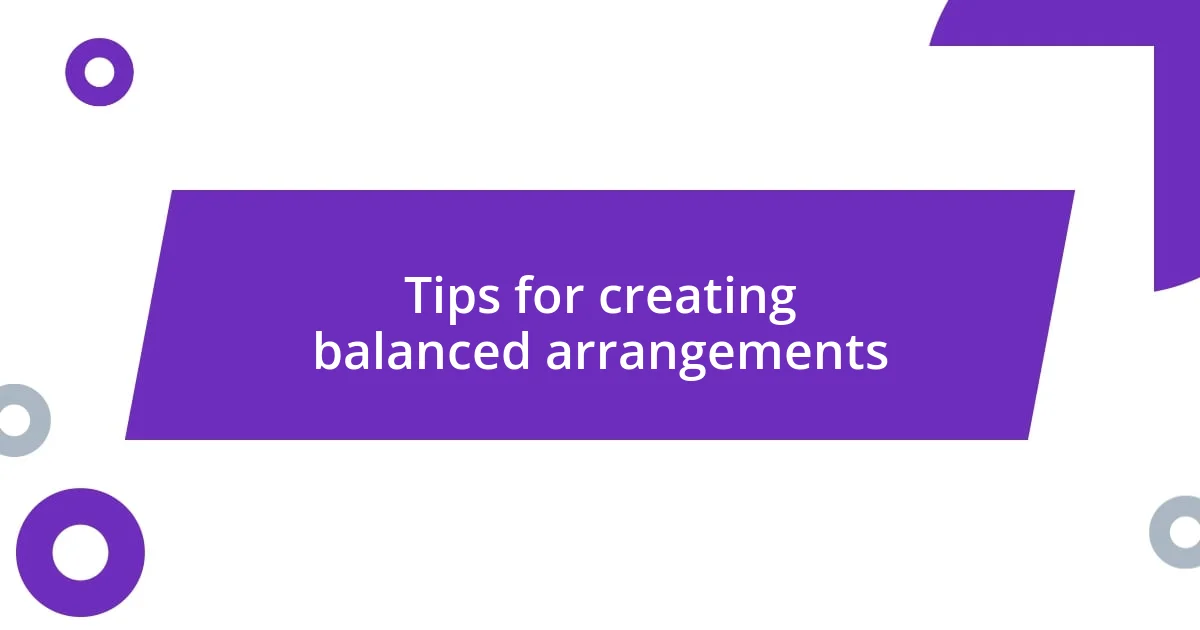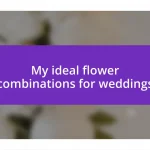Key takeaways:
- The “triangle method” helps achieve balance in floral arrangements through careful positioning of flowers.
- Choosing flowers based on seasonality, symbolism, and texture enhances both the beauty and meaning of designs.
- Effective layering involves starting with a strong foundation, varying heights, and incorporating negative space for visual elegance.

Understanding floral design basics
Floral design is about more than just picking pretty flowers; it’s an art that blends color, shape, and texture. I remember attending my first floral workshop, feeling overwhelmed by the sheer variety of blooms and foliage available. It sparked a question: How do you create harmony among such diverse elements?
One fundamental concept in floral design is the “triangle method,” which creates balanced arrangements by positioning flowers in a triangular formation. This principle transformed my early attempts, guiding my hand as I learned to envision how shapes interact with one another. If you’re struggling to find balance, have you considered how the positioning of each flower affects the overall composition?
Color theory is another key aspect that brings life to floral arrangements. I once experimented with complementary colors—opposites on the color wheel—only to be amazed by the vibrant contrast they created. It felt like discovering a new language in design, one that whispers to the viewer’s emotions. Have you ever noticed how certain combinations can evoke specific feelings? Understanding these basics is really the first step toward crafting your own unique floral stories.

Choosing the right flowers
Choosing the right flowers is a pivotal step in floral design, and it can feel daunting when faced with so many options. I vividly recall a time when I was planning a wedding arrangement and spent hours at a flower market, overwhelmed yet exhilarated. It was then that I learned the importance of not just choosing the flowers I loved, but also considering the seasonality and availability. Finding flowers that thrive in the season for your arrangement can dramatically enhance not only the beauty but also the longevity of your designs.
In my experience, thinking about the meaning and symbolism of flowers is just as crucial as their aesthetic appeal. For instance, I often choose peonies for their luxurious blooms and connotations of love and prosperity. I find that sharing these meanings with clients adds a deeper connection to their arrangements. Have you ever given a bouquet that resonated with the recipient’s emotions? It’s moments like those that truly highlight the power of selecting the right flower.
Lastly, texture plays a significant role in flower selection. Mixing different flower textures can create visual intrigue and depth. One of my favorite combinations includes the soft, ruffled petals of a rose with the sturdy, spiky presence of thistles. This contrast not only draws the eye but also sparks conversation. As you contemplate your flower choices, which textures speak to you and what story do you want to tell with your arrangement?
| Flower | Season |
|---|---|
| Peonies | Spring |
| Roses | Available Year-Round |
| Thistles | Summer to Fall |
| Lilies | Summer |
| Dahlias | Late Summer to Fall |

Tools and materials for layering
When it comes to layering in floral design, having the right tools and materials is essential. Over the years, I’ve discovered how each tool serves a unique purpose in achieving the depth and texture that make an arrangement truly stand out. For instance, investing in good quality floral shears has revolutionized my cutting technique—clean cuts not only extend the life of the flowers but also make for a neater arrangement. It’s like crafting a masterpiece where each stroke matters.
Here are some key tools and materials I recommend for effective layering:
- Floral Foam: Provides structure and stability for your arrangements.
- Tape: Clear or floral tape helps secure stems and create a grid for easier layering.
- Wire: Floral wire is invaluable for supporting delicate flowers or adding height.
- Shears: Invest in sharp, reliable floral shears for clean cuts.
- Vase or Container: Choose one that suits the arrangement while providing enough space for layering.
Through trial and error, I’ve also learned to appreciate the impact of colors and materials, like adding foliage or berries, which can texture layers beautifully. My friend once told me how the addition of eucalyptus leaves transformed her simple bouquet into something lush and enchanting. It reinforced my belief that layers are not just about arranging flowers; they’re about creating a harmonious visual narrative. What tools do you find indispensable in your own layering journey? Will experimenting with new materials inspire fresh ideas in your designs?

Techniques for effective layering
Layering effectively in floral design is about more than just placing flowers on top of one another; it’s an art form that requires thoughtful consideration. One technique I swear by is starting with a sturdy foundation. I learned this when I once rushed my arrangement, neglecting to secure a strong base. The result was a lopsided display that fell short of my vision. Now, I prioritize a solid structure right from the start, using floral foam or grid tape to keep everything in place.
Another crucial aspect is the varied heights and angles of the layers. During one memorable event, I experimented with cascading flowers, like trailing ivy combined with bold sunflowers. The dynamic movement created a conversation piece, capturing everyone’s attention. It was in that moment I realized the impact of height; it draws the eye and adds visual drama. Have you ever noticed how a well-structured arrangement can completely alter the room’s vibe? It’s all about keeping things interesting.
Lastly, don’t underestimate the power of negative space. Initially, I thought every spot needed to be filled to look great. However, I discovered that allowing some spaces to breathe can enhance the beauty of your arrangement. At a recent workshop, a fellow designer showcased a simple bouquet with ample negative space that made the colors pop. I found it striking how much a little space can lend to a design’s overall elegance. How do you approach negative space in your own work, and have you found it changes how you perceive an arrangement?

Tips for creating balanced arrangements
Creating truly balanced floral arrangements is paramount, and it starts with considering weight distribution. I remember crafting a centerpiece for a wedding where I placed all the heavy flowers on one side—it looked top-heavy and awkward. By intentionally spreading out the heavier elements across the design, I discovered the arrangement needed a sense of equilibrium, making it pleasing to the eye. When you’re layering, think about how the weight of your flowers can affect the overall balance.
Next, think about color harmony. There was a time when I used wildly contrasting colors without much thought, which led to a chaotic result. Now, I carefully select colors that complement each other, creating a cohesive look. For example, pairing soft pastels with deep jewel tones not only brings depth but also promotes a balanced visual experience. What color combinations have you found elevate your arrangements?
Texture also plays a critical role in achieving balance. I’ve had moments when I focused solely on floral variety, overlooking the importance of varied textures. Once, I integrated smooth roses with textured thistles and feathery ferns. The contrast not only added intrigue but also balanced the composition. How do you approach texture in your designs, and have you seen it transform your arrangements?

Showcasing layered floral designs
When it comes to showcasing layered floral designs, the arrangement should tell a story. I once created a striking display for a gallery opening, using layers that reflected the artwork around it. I meticulously placed vibrant dahlias in the foreground, allowing delicate white orchids to peek through from behind. The result? A narrative of boldness intertwined with elegance. Have you ever considered how your floral designs can resonate with their environment?
Lighting is another factor I’ve come to appreciate deeply. I vividly remember a wedding where soft, shimmering lights added dimension to my layered bouquet. The way the petals caught the glow transformed the colors and created a magical atmosphere. It made me realize that showcasing layers isn’t just about the flowers themselves; it’s about how they interact with their surroundings. How do lighting and ambiance influence your own designs?
Finally, I’ve found that incorporating unexpected elements can elevate a layered arrangement. One time, during a personal project, I added feathers and seasonal fruits to my bouquet. The layered textures created depth and sparked curiosity. It was an unexpected twist that I loved—the way those extra touches made the display feel alive and dynamic. What unique elements have you dared to incorporate into your floral designs, and how did the audience respond?














